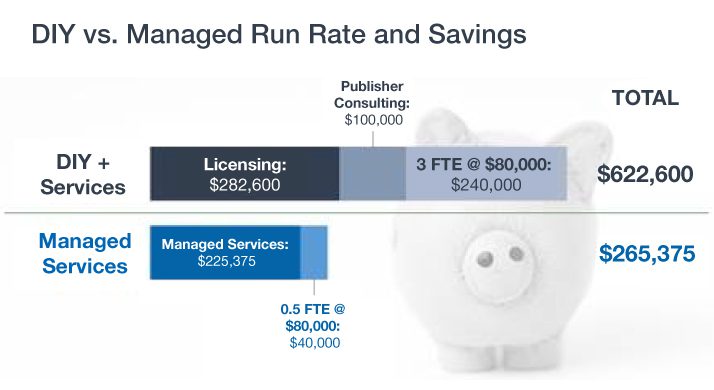Choosing an ITAM solution: DIY vs. managed service

A lot of organizations struggle to get started with IT asset management (ITAM).
There are typically two main options. Either you buy ITAM software and handle it in house, or you hire a partner to run some — or all — of your program for you as a managed service. If you’re on the fence, we’re going to walk through all the factors you need to consider before making a decision.
It’s an important choice that depends on the makeup of your organization and what you’re willing to accept in terms of control, effort, and trust. Here’s everything you need to know about ITAM so you can make a wise choice.
DIY vs. managed service ITAM
Pros of DIY: When you handle ITAM internally, you maintain control. You make all the decisions and that can be a comfortable position to be in.
It’s also contained: No outside organizations access your information so there are no data transit or external security issues. Your ITAM program is also independent. You do what you want, when you want to, how you want to, without having to take into account anyone else’s schedule or priorities.
Cons of DIY: On the other hand, experts industry-wide have shown that DIY ITAM has a 70% failure rate, caused by everything from internal politics to struggling to meet scheduled milestones to an inability to show a return on investment. There’s also a high total cost of ownership. When you add up the licensing costs of a tool, plus maintenance, support, additional tooling for specialty products, and several full-time employees, it can quickly become cost prohibitive.
DIY also has a long time to value. It takes about three years on average — and sometimes as many as five or six years — for an organization to report ROI or decide that the effort was a failure and move on to another option.
Pros of managed services: Managed service providers offer access to a broad base of expertise that you don’t need to build in house. They’re usually much more efficient — they’ve been through the process countless times and have encountered every technical, licensing, and internal communication issue you can think of, and they have ways to quickly mitigate them. As a result, managed service programs are often up and running in just three to six months.
Managed services also tend to have lower costs. Though it may sound counterintuitive, the economies of scale that managed services offer usually result in costs less than the licensing, maintenance, staffing, and additional software costs associated with DIY methods.
Cons of managed services: One of the downsides is that you become dependent on the provider and its experience, which can be uncomfortable for some organizations. Consultants and SMEs outside your organization will be processing, collecting, storing, and securing your ITAM information, so it’s important to ensure security policies are tight. If your provider changes course, you may feel like you can’t influence those decisions as much as you’d like.
Working with a partner requires trust — you need to know they have your back and are working in your best interest to produce results that are reliable and trustworthy. It might take some interviewing to find a partner you’re comfortable with.
How to get started with ITAM
Before you choose, create a plan for what you want to accomplish and consider which of the two options could get you there faster with the more accurate results.
- Determine your desired outcomes. Are you looking to reduce costs, overspending, risk, or all of the above? Too many organizations set out to manage their assets without a clear plan for what that means, what the outcomes should look like, and how they intend to define and measure success. When there are no clear expectations, not everyone will be satisfied with the results.
- Assess your existing skill sets. Do you have in-house licensing expertise for the Big 5 publishers and others relevant to your organization? If not, what is your timeline for recruiting that talent and how much budget do you have to carry those additional employees? No matter how much you spend on ITAM software, if you don’t have the right people to run it, your program won’t succeed.
- Determine the division of labor and responsibility. Sketch out both scenarios — what it would look like and cost internally and with a partner. I find creating a RASCI chart can be particularly helpful in breaking down who’s responsible and accountable. It’s a good exercise that pushes you to confront just how much effort will be required and which internal groups will need to be involved.
- Estimate ROI. Based on the first three elements, you’ll be able to calculate your costs to get an idea of what run rates will look like, how much you can reasonably expect to save over a certain period of time, and how long you might reasonably wait to see that ROI. Remember one of the most important rules of IT asset management: The program should be self funding. If forecasted cost reduction is less that the run cost of the program, the plan needs to be re-worked.
One of the two options will emerge as the stronger, more cost-effective choice. That makes it easier to make your case for budgeting and long-term planning and gives you greater confidence in your choice.
Successful ITAM adoption starts here
On the surface, ITAM can seem simple. But it quickly becomes complicated and time consuming. No matter what choice you make, be sure you fully understand the requirements and risks of each option and select the one that makes the most sense for your organization.
Whether you’re ready to get started, want to bounce some ideas off of an ITAM SME, or simply want to talk through the options, contact your SHI account executive for more information.





